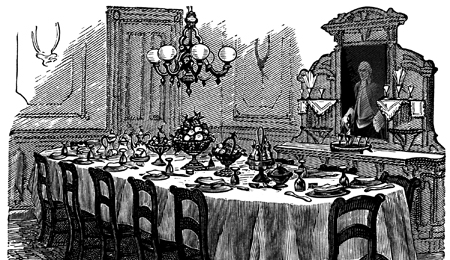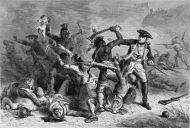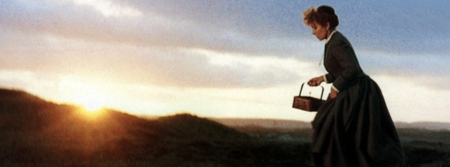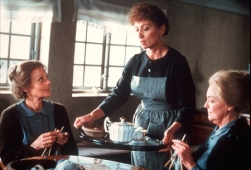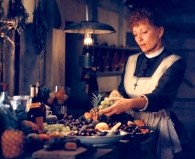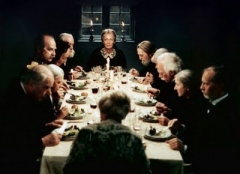A memory can make an indelible impression on a young mind like that of a potters mark in soft clay. Once fired, that mark lasts as long as the vessel itself.
 One evening, when I was around 12 years old, was an evening of many firsts: first “real” restaurant, first link with a living history, and first (and last) lobster. My family was visiting my sister who was attending college in Glenns Falls, NY. To celebrate the occasion, my dad decided to take the whole family out to a “fancy” restaurant in the area called the “Montcalm” that he had heard good things about. Back then, the Montcalm was located on the grounds of what once was Fort William Henry, on the shore of Lake George.
One evening, when I was around 12 years old, was an evening of many firsts: first “real” restaurant, first link with a living history, and first (and last) lobster. My family was visiting my sister who was attending college in Glenns Falls, NY. To celebrate the occasion, my dad decided to take the whole family out to a “fancy” restaurant in the area called the “Montcalm” that he had heard good things about. Back then, the Montcalm was located on the grounds of what once was Fort William Henry, on the shore of Lake George.
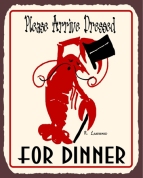 Back in the early 70’s, it was still the style of people to dress up before going to dinner. Now, I’m all for casual Friday’s and such, but I feel we, as a culture, have lost much by giving up this tradition in America. I used to enjoy the preparation and subsequent buildup of anticipation to the special event. There was also a kind of respect for oneself, fellow-diners, the restaurant itself…but mostly for the respect for the family occasion of dining out.
Back in the early 70’s, it was still the style of people to dress up before going to dinner. Now, I’m all for casual Friday’s and such, but I feel we, as a culture, have lost much by giving up this tradition in America. I used to enjoy the preparation and subsequent buildup of anticipation to the special event. There was also a kind of respect for oneself, fellow-diners, the restaurant itself…but mostly for the respect for the family occasion of dining out.
So, resplendent in my suit-coat and tie, I go to my first real dining experience. I remember the Montcalm being large, somewhat dark, with eclectic artwork. My memory is bit fuzzy here, but I believe they attempted to recreate the feel of the fort in the overall decor. The focus of the dining room was a roaring fireplace, over which was a portrait of what obviously was a military man in a light blue uniform. From the clothing, hair style, weapons. etc. in the portrait, I judged the time period to around the Revolutionary War. To my query about the portrait, my dad gave me a history of the place.
 My dad explained that Fort William Henry was an English fort against the French in a war, that among other things, was the battle over which nation would rule what would eventually become the United States and Canada. As Americans, we call this the “French and Indian War” because that’s who “we” (as we were British back then) were fighting (although the British used Native American allies as well…largely the Iroquois nations against the Hurons, Ottawa, and Abenaki, who were allied to the French.) In the wider European aspect, this conflict was called the “Seven Years War.”
My dad explained that Fort William Henry was an English fort against the French in a war, that among other things, was the battle over which nation would rule what would eventually become the United States and Canada. As Americans, we call this the “French and Indian War” because that’s who “we” (as we were British back then) were fighting (although the British used Native American allies as well…largely the Iroquois nations against the Hurons, Ottawa, and Abenaki, who were allied to the French.) In the wider European aspect, this conflict was called the “Seven Years War.”
General Marquis Louis-Joseph de Montcalm was the French commander attacking the fort. After several days of bombardment by the French, the British commander of Fort William Henry, Colonel Edmund Munro, met with Montcalm in parley for terms of surrender. Munro was surprised with General Montcalm’s generous terms for the fort’s surrender: all people in the fort were allowed to leave safely, with their arms…an almost unheard of convention, under the condition that they do not take up arms again against France.
As the British were leaving the fort, they were attacked by over 2000 French-allied Native Americans who saw the surrender as robbing them of the spoils of war. They wounded, killed or captured, not only soldiers, but many men, women, and children the soldiers were to protect. Numbers vary, but later research seems to suggest that over 150 people were lost, under the most brutal conditions, in the attack.
When I asked my dad why anyone would name a restaurant after a commander who essentially “beat us” my dad thought for a moment and said that it was probably for the honor and respect Montcalm bestowed upon Col. Munro and the residents of the fort, despite being victorious over them.
I had other questions for my father that night, not all of them about history. Up to this point the only waiters I had ever seen were the ones at Howard Johnsons and Friendlys. These were different: dressed in formal service attire complete with bow tie, vest and a longer-tailed suitcoat. The bussers (which I had never seen before…dad explained their function) were dressed in their own more simple uniform. I remember being amazed and anxious that the waiters could balance huge trays with just one hand. I also asked dad why we were served salad before the meal (at home we always had it after the main course) to which dad told me it was to keep us quiet while the staff could make the main part of the meal. Before we ordered, dad talked me into having a whole lobster, which I had never had before.
Many years later, reading up on the history of the Seven Years War, I came across the Battle of Fort William Henry, and discovered that it was generally accepted that Montcalm himself tried to stop the attack on the citizens of the vacated fort, but the violence had escalated too far by that point. I also found that being on the “frontier” like they were, residents of New York State had more dealings with and trading between, the French and so were a little bit more accepting that the British hard-liners from other areas. More reasons, I suppose, why there would be such a place dedicated to Montcalm in New York State.
Just before the meal came, the waiter helped me on with what I was to discover was a required accoutrement: a lobster bib. I was at an age where I found this all very embarrassing. After the waiter left, I asked my dad if the bib was truly required. With a chuckle, dad told me that I would find it very helpful once I started eating. The next set of tools the waiter gave me was a nut cracker and a small pick. “What am I getting myself into?!!!” I thought to myself. When the lobster came, I had even more reservations. “Looks like a big BUG!” I told dad. “Yeah.” he said, “That’s pretty much what it is: a big, oceanic bug! But it is also delicious!” Dad proceeded to give a few lesson on how to crack the shells and pick out the meat, told me not to eat the organs, etc. Dad was right, it was delicious, but all-in-all a little too messy for my tastes! Although I have happily prepared lobsters for others (even professionally…as a chef’s assistant in a French restaurant) I have never eaten lobster since that night.
So, the lobster didn’t make a big impact, but the history did. Years later, I was reading “The Last of the Mohicans” by James Fenimore Cooper and realized that the whole story takes place right around the area of the Montcalm, where I had dined so many years previously! In fact, the genesis of the whole story was when Cooper visited the cave under the Glenns Falls. When a friend of his commented on the cave by saying “here was the very scene for romance” Cooper promised the friend that he would write a story worthy of that “romance.” By doing so, Cooper became America’s first internationally recognized novelist.
Cooper’s story begins a few days preceding the French attack on Fort William Henry. The hero, Hawkeye, and his adoptive Mohican father Chingachgook, and brother Uncas, are hunting in the woods west of Albany, when they foil an attack on a party traveling from Albany to the fort. The attackers are Hurons, led by the villain of the story, Magua. The party is led by British Major Duncan Heyward, who is guiding Col. Munro’s daughters, Cora and Alice, along with a singing instructor, David Gamut, to Fort Henry. After the Hurons are either killed or driven off by Hawkeye and the Mohicans, and realizing Magua (who escaped) would return with reinforcements, they lead the group to a secret cave under the falls, where they spend the night in safety before continuing on to the besieged fort.
Hawkeye is just one name for Cooper’s hero, who seems to have more monikers than any other figure in literature. He is also “The Trapper;” “Le Longue Carabine (the long rifle);” “Leatherstocking;” “Pathfinder;” “Deerslayer;” and (oddest of all, what seems to be Hawkeye’s birth name) “Natty Bumppo!” I’m not quite sure what he was thinking with all the names, but perhaps to Cooper, the number of names suggests the varied people Hawkeye comes in contact with and the esteem they hold for him. The “Natty Bumppo” only makes me think of an early “A Boy Named Sue” by Johnnie Cash (as in…with such a silly name he’d just have to grow up a tough tracker!)
“Last Of The Mohicans” is the second of the five “Leatherstocking Tales” by Cooper, all with Hawkeye as each book follows him through different phases of his life. I always think of Cooper and his hero as I travel by the “Leatherstocking Region” sign on the NYS Thruway on my way home, but I never really knew its’ context. Turns out “leatherstocking” is what the Native Americans call boots.
Revisiting Cooper’s writing, I found it a bit uneven: his style can actually be confusing to the point that I often did not know what I just read. I admit, that I tend to race through a book, so when I slowed it down a bit, Cooper’s style became a little more readable. Cooper’s writing style so angered Mark Twain, that he felt compelled to write an essay called “Fenimore Cooper’s Literary Offenses” and even started a Huck Fynn/Tom Sawyer parody of “The Last Of The Mohicans” but gave it up before publishing. There is the occasional historical inaccuracy or confusion in Cooper’s writing, also. Like the name, “Mohican”…no such Native American tribe. Did Cooper mean “Mohegan?” “Morican?” “Mahikan?” Cooper also consistently calls Lake George by “Horican” throughout the book, but that seems to be a name he picked up (yet another Native American tribe is “Horican”) because he liked the sound of it. To the casual reader, there are other confusions. Like why, if the Iroquois are allied to the English does Hawkeye consider them enemies? It could be that Hawkeye is allied to the Mohicans, a subset of the Delaware tribe, and they are enemies to the Iroquois. But Cooper clearly states that the Iroquois are allied with the French! As the group is coming close to the fort, Hawkeye warns them, “Montcalm has already filled the woods with his accursed Iroquois.” A bit of sloppy history research, there. All this may be historical nit-picking, but only if the story holds up. Unfortunately, it sometimes doesn’t.
At a couple of places, the inconsistencies of character or situation tore me right out of the reading. One instance: while holed up in the cave under the falls, Hawkeye allows the singing instructor, David Gamut, to sing a song, and then proceeds to get a little weepy when he does. All this while they are being hunted by the Hurons! OK. Wrong place! Wrong time! Wrong action! I picture the Mohicans frantically priming their weapons, while rolling their eyes at Hawkeye!
There is also Hawkeye’s treatment of Cora and Alice. So…we have a 40-year-old man…who has spent a lot of time in the woods…with just male Mohicans to hang out with. He meets two attractive, vibrant, young women and after an adrenaline-infused rescue, what does Hawkeye do? He nods, smiles at them and then starts treating them like sisters! I mean, the girls have been around (you know…London, Boston, Albany) I’m sure they have some great stories to tell, but does he engage them? Noooo…not the boyscout Hawkeye!
I can’t help but picture the following conversation:
Cora: “What’s with this guy?”
Alice: “I know. I mean, we’ve been on the trail for a few days…but jheesh!
Cora: “Hey, look. Is dung on my dress? Venison in my teeth?”
Alice: “No..no. Ya think maybe he’s a little…[teeters hand vertically]?”
Cora: “Mm…maybe when you’re in the woods too long, social skills get..um..mossy!”
Alice: “Say, I wonder if his Mohican friends are free?”
Cora: “Yeah! Dibs on the young one!”
The worst offense by Cooper takes place at the start of the massacre of the fort populace. A woman and her baby are slaughtered in an extremely violent manner. Yikes! I only hope that all the high schoolers reading “LOTM” as required reading are warned ahead of time!
So…a few problems with style and consistency. Still, “LOTM” has good story potential, if one could iron out all the highs and lows.
Luckily, someone has.
Michael Mann’s 1992 version of “Last Of The Mohicans” totally morphs Cooper’s book, smooths out all the story bumps; adds exciting battle scenes (both hand-to-hand and on a large-scale); romances; a villain you love to hate; sweeping panoramas of nature; an near-perfect film score; accurate costumes and makeup; and stocks the film with some of the best actors available at that time.
Hollywood has made four versions of “LOTM” (1920, 1932, 1936, and 1992.) I think it interesting that in the 23 years since Mann’s “LOTM” no one has dared a re-make. I think Hollywood acknowledges that it would be silly to tamper with perfection!
Although I mourn Mann’s choice to substitute my native New York with North Carolina as a setting, I understand that the Adirondacks don’t look quite the way they did in 1757. NC is an excellent stand-in with its majestic forests, steep rocky cliffs, raging waterfalls, and clear rivers. You can tell how much effort went into set design, wardrobe, and makeup (notice the warpaint of each Huron, for instance: no two look like…the way it would have been!)
Daniel Day-Lewis has played more challenging and provocative roles before and since, but he is the perfect Hawkeye: what every boy wants to be, yet what every lady likes to look at! Day-Lewis plays Hawkeye as tough and capable, with a bit of a snide humor, and best of all, he has the capability to be sensitive, romantic, and tender. NO wooden boy scout here! Day-Lewis has rounded Hawkeye out into a full figure of man! At the time of filming “LOTM,” Day-Lewis was at the height of his immersing himself in the role part of his career. DDL stayed out for weeks before the shoot in the woods, eating only what he could bring down himself.

“Forget all that ‘Natty Bumppo’ stuff, Miss Cora. Here, I’m called Nathaniel…or even better…just call me ‘Hawkeye'”
Mann has (mercifully) changed Hawkeye’s name to the more dignified “Nathaniel Poe.” Where the book is almost devoid of romance, in the film everyone is in love: Hawkeye loves Cora, and so does Heyward. Uncas loves Alice. I would go as far as to say that Hawkeye and Cora’s love scenes are as smoking hot as a director can show with the leads still wearing clothes!
In fact, all the emotions are amped up in Mann’s film. The best is how he has changed Magua. In Cooper’s book, Magua’s motivation of revenge is because Col. Munro introduced Magua to alcohol and when Magua acts up under the influence, Munro has him whipped. So…Magua is a mean drunk with a grudge. The film Magua, played to perfection by Wes Studi, is a lean, brooding, stealthy, sociopath, always an inch away from violence. This Magua has a real reason for a grudge: Munro has made Magua lose his entire family and had him driven from his tribe so that he has to be adopted by his enemy, the Mohawks, in order to survive. Magua not only wants to kill Munro, he wants to eat his heart, but only before he has killed his daughters in front of him, so Munro knows his whole line dies under Magua’s tomahawk!
One other change Mann makes is that of his character of Montcalm. After Montcalm has graciously allowed the English to leave the fort, he clandestinely meets with Magua, and implies that he would rather not meet these English again as he drives his forces towards Albany. Magua picks up on the hint and organizes the massacre, thereby enabling a chance for revenge on Munro.
I began to see that there are as many versions of Montcalm’s actions prior to, and during the massacre in media since 1757. Even Cooper has a more abject version of Montcalm’s actions. After the massacre has begun, Cooper’s characters are observing from a nearby mountain:
“The cruel work was still unchecked. On every side the captured were flying before their relentless persecutors, while the armed columns of the Christian king stood fast in an apathy which has never been explained, and which has left an unmovable blot on the otherwise fair escutcheon of their leader.”
[This being a fair sample of how convoluted Cooper’s writing can be, but what he seems to say is:] “Montcalm stood by and did nothing to save the fort’s inhabitants.”
I think these versions exist as they make good drama. But in actuality, why would Montcalm behave more honorably than just about any military leader known one day, and then behave so dishonorably the next? Not only is not keeping in character, but there is only one way his colluding with the attackers could benefit him: if there was not a single survivor, and that was something he could not possibly guarantee. If word got back to the English of his collusion, the only possible reaction for them would be hatred toward a dishonorable foe. As it was, the outrage over the massacre would never be surpassed in America, until after Santa Anna decimated the Alamo!
I tend to take whatever version of history with a grain of salt. There are many variations of events that have taken place just yesterday. To find the absolute truth in actions taken place 258 years ago, is next to impossible. All one can do is look at the general character of Montcalm. He was brave, a good leader and military strategist. At the very least, he feigned honor in the occasion of Fort William Henry, if only for the sake of good form. Having made this stand, why would he then renege on it when he knew the outcome would only to have history typecast him forever as a scoundrel?
Just when I reached a point of frustration with Cooper’s writing, I read a section from the earlier Leatherstocking Tale, “Deerslayer.” In this tale, Hawkeye is younger and has met an older fellow tracker called “Hurry Harry ” who gives Hawkeye his opinion of the races. He rates the white race as the highest. Blacks he considers “useful.” His opinion of the American Indian is the worst of all. He tells Hawkeye: “You may account yourself as a red skin’s brother, but I hold ’em all to be animals, with nothing human about ’em but cunning….”
One begins to think that maybe Harry is in a “hurry” to judge his fellow-man.
Hawkeye’s response is perfect: “I look upon the red men to be quite as human as we are ourselves…. They have their gifts, and their religion, it’s true, but that makes no difference in the end, when each will be judged according to his deeds, and not according to his skin.”
Sadly, history was not written in the woods of the frontier. History was (and still is) written in the towns of the victors… and History (with all its inconsistencies) chronicles the general movement of us over time:
The British overcame the French. We overcame the British.
The “frontier” of Eastern New York State did not stay still. It was pushed constantly westward until no frontier exists in our United States. Along with this sweeping frontier, we wiped the original inhabitants away. We will never completely know the could-have-been-contributions of a Peoples who might have added much (as did subsequent immigrants) to the textured amalgamation that is America culture.
Montcalm lost his life fighting the British in the Battle of the Fields of Abraham, outside of Quebec.
The falls that covered the real cave that inspired James Fenimore Cooper to write “Last Of The Mohicans” has long since been dammed over…it’s once raging flow restricted and tamed.
The restaurant named after Montcalm, that I dined at so many years ago, moved from the shore of Lake George, to a few miles away in 1984. It was closed in 2013 and now a shopping center exists where it once stood.
It has been some years now, that I have had the joy and benefit of the culinary prodding to adventure and impromptu history lessons from my father.
Times change, but our memories, cemented into words, become what we call “History.” Generation after generation, we put these words down. In a sense, we are all the last of our kind. Best stated by Uncas, who at the end of Mann’s film, finding himself to be “The Last Of The Mohicans” our stories let the world know:
“But once, we were here.”
[Much thanks to Jim Dowrey for his wonderful historical mind and for his memories of what fine dining was like back in the day.]

